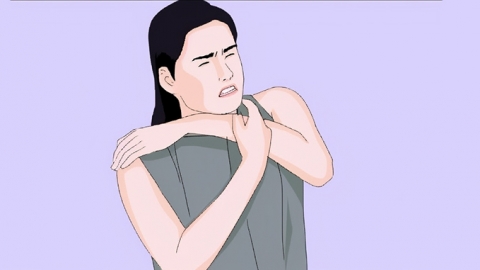There is a black, hard lump under the skin of the shoulder with pain; what could be the cause?
There may be a black hard mass under the skin of the shoulder with pain, which could be caused by overexertion, poor posture, trauma, sebaceous cysts, or shoulder periarthritis. Appropriate management can be selected according to the specific situation. If discomfort occurs, it is recommended to visit a hospital promptly for diagnosis and follow medical advice for treatment to avoid delaying the condition.

1. Overexertion: Prolonged shoulder load or frequent activity can cause repeated friction and wear of the muscles, leading to local tissue ossification forming a hard mass and accumulation of metabolic waste products causing pain. Reduce strenuous shoulder activity, rest more, and appropriately massage the shoulder for 15-20 minutes each time with moderate pressure to promote blood circulation and relieve discomfort.
2. Poor posture: Long-term poor posture such as head-down or chest-in positions can cause shoulder muscle tension, affect local blood circulation, lead to tissue hardening forming a hard mass, accompanied by soreness. Correct poor posture, move the shoulder regularly, perform shoulder shrugs, chest expansions, and similar exercises, 3-4 sets daily, 10-15 repetitions per set.
3. Trauma: After shoulder trauma such as impact, subcutaneous blood vessels may rupture and bleed, causing blood accumulation forming a black hard mass with pain. Apply cold compresses within 72 hours of injury, 15-20 minutes each time, 3-4 times daily to constrict blood vessels and reduce bleeding; apply warm compresses after 72 hours to promote blood absorption and dissipation, usually symptoms alleviate within 1-2 weeks.
4. Sebaceous cyst: Blockage of the sebaceous gland excretion duct causes the cystic epithelium of the sebaceous gland to gradually expand due to increasing contents, appearing black in color, and pain may occur if infection develops. It is recommended to use medications such as Amoxicillin Capsules, Cefixime Dispersible Tablets, and Mupirocin Ointment under a doctor's guidance to alleviate discomfort.
5. Shoulder Periarthritis: Shoulder joint wear and degeneration can lead to aseptic inflammation in the soft tissues around the shoulder joint, causing local tissue adhesion and hardening, possibly resulting in a hard mass and pain that worsens with movement. Patients may follow medical advice to use medications such as Ibuprofen Sustained-Release Capsules, Diclofenac Sodium Enteric-Coated Tablets, and Yunnan Baiyao Plaster to improve symptoms.
Rest adequately and avoid excessive shoulder movement. Perform shoulder functional exercises regularly, such as wall climbing exercises and pendulum swings, to improve shoulder function.
References:
[1] Zhu Luxia, Li Wenyang, Bao Yimei. Advances in the diagnosis and treatment of shoulder periarthritis [J]. Xinjiang Journal of Traditional Chinese Medicine, 2024, 42(06): 149-152.
[2] Shi Yongchao. Clever identification of common causes of shoulder pain [J]. Health Wonders, 2025, (02): 18.





